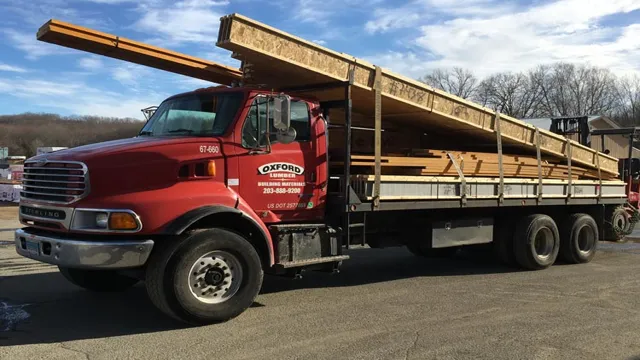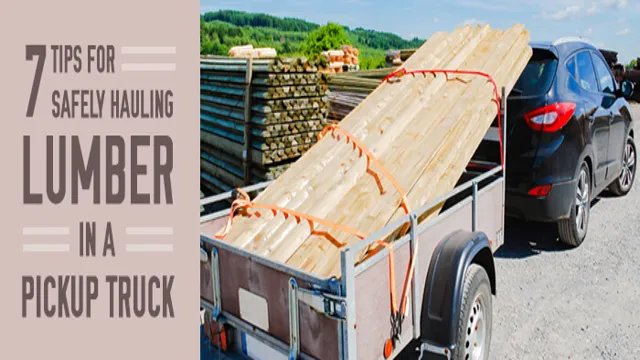Have you ever found yourself in the tricky situation of needing to transport 20-foot lumber, but you’re not sure where to start? It can be overwhelming to know where to begin, especially if you’re not used to transporting large or heavy objects. But fear not! We’ve put together a comprehensive guide to make the process as simple and stress-free as possible. Transporting 20-foot lumber requires careful planning and attention to detail, but with the right tools and knowledge, you’ll be able to do it in no time.
Whether you’re a seasoned pro or a first-time lumber transporter, this guide will provide you with all the information you need to get the job done right. We’ll cover everything from the equipment you’ll need to the best methods for securing your lumber to your vehicle, to ensure that it arrives at its destination safely and securely. We’ll also provide helpful tips and tricks to optimize your transportation experience.
So, whether you’re transporting lumber for a DIY project or as part of your profession, read on to discover everything you need to know about transporting 20-foot lumber.
Choosing the Right Vehicle
If you’re planning to transport 20-foot lumber, you’ll need to choose the right vehicle that can accommodate such a long load. The most common options to consider are flatbed trucks, trailers, or pickups with attached racks. Flatbed trucks are ideal if you have a large quantity of lumber to transport, as they offer ample cargo space and can safely carry heavy loads.
Trailers are a bit more versatile, as they can attach to most vehicles and come in different sizes to fit your specific needs. Finally, pickups with attached racks are a great choice for shorter distances or smaller quantities of lumber. Whichever option you choose, make sure to secure the lumber tightly to prevent shifting or falling off the vehicle during transport.
With the right vehicle and proper securing, transporting 20-foot lumber can be a safe and efficient process.
Consider weight limit and size of the lumber
When it comes to transporting lumber, choosing the right vehicle is crucial. You need to consider both the weight limit and size of the lumber to ensure a safe and efficient journey. If you’re only transporting a few boards, your pick-up truck may suffice.
However, if you’re hauling larger quantities, you may need to opt for a flatbed truck or trailer. These vehicles are designed to handle heavier loads and offer more space for your lumber. But keep in mind the weight limit of your chosen vehicle, as exceeding it can result in damage to your vehicle or even worse, accidents on the road.
So, before hitting the road, be sure to do your research and choose a vehicle that can safely and comfortably transport your lumber. Remember, safety should always come first!

Assess your transportation options
When it comes to choosing the right vehicle, there are several factors to consider. First, determine your specific needs and preferences. Are you looking for a fuel-efficient option for daily commuting, or do you need a spacious vehicle for a growing family? Do you live in an area with rough terrain or inclement weather, requiring a vehicle with all-wheel drive or four-wheel drive? Once you have narrowed down your options based on your needs, consider the cost of ownership, including maintenance and insurance.
It’s also important to test drive the vehicle to get a feel for its handling and performance. Ultimately, choosing the right vehicle is about finding the right balance between practicality and personal preference. Don’t rush the decision – take your time to assess your options and choose the vehicle that best meets your needs and fits your lifestyle.
Preparation Before Transporting
Are you planning to transport 20 foot lumber? It’s important to prepare before you hit the road. First off, you’ll need to have a sturdy flatbed truck or trailer that’s capable of carrying heavy loads. Make sure your vehicle is properly maintained and has the necessary equipment, such as tiedowns and straps, to secure the lumber during transport.
In addition, it’s important to measure the lumber to ensure that it fits on your vehicle and complies with transportation regulations. It’s also a good idea to inspect the lumber for any defects or damage before loading it onto your vehicle. Finally, check the weather forecast and traffic conditions to plan your route and schedule your transport accordingly.
By following these steps, you can ensure a safe and successful transport of your 20 foot lumber.
Secure the load with straps and chains
When transporting cargo, one of the most crucial steps is to secure the load with straps and chains. This preparation step ensures that your cargo stays safe and secure during transport, preventing any damage or accidents along the way. First, make sure to inspect the straps and chains for any signs of wear and tear, as using damaged equipment can result in disastrous consequences.
Secondly, use the right kind of straps and chains for your cargo’s weight and dimensions, making sure to distribute the weight evenly across the load. Lastly, tighten the straps and chains to a secure tension and double-check everything before heading out. Remember, a secured load not only protects your cargo but also keeps other drivers on the road safe.
So, never skimp on securing your load; it’s the best way to get your cargo to its destination safely and soundly.
Protect the sharp edges and corners
When preparing to transport items, it’s important to pay close attention to the sharp edges and corners. Protecting these delicate and potentially dangerous areas is essential to ensuring a safe and successful move. To start, wrap all sharp edges and corners with bubble wrap and/or packing paper.
This will prevent scratches, dents, and any other damage that could occur during transport. You could also use packing tape to secure the wrap in place, creating an extra layer of protection. When packing these items into boxes, be sure to choose one that’s sturdy and has enough padding to keep your items safe.
Remember, protecting your sharp edges and corners is crucial for preventing any mishaps during the transportation process, so take the time to prepare properly and avoid any unwanted accidents.
Check your vehicle and the road ahead
Before transporting your vehicle, it’s essential to check your vehicle and the road ahead. One of the most crucial things to consider is the condition of your vehicle. Ensure that the vehicle is in good working order and that there are no mechanical faults or problems.
Check the brakes, tires, lights, and other safety features to ensure your car is roadworthy. It’s also crucial to check the weight and dimensions of your vehicle to ensure that it meets the requirements for the type of transporter you intend to use. Additionally, before moving your vehicle, it’s a good idea to survey the route ahead and be aware of any potential hazards or obstacles.
Check for any roadblocks, traffic, or hazardous weather conditions that could affect your journey. Doing these checks before you transport your vehicle can prevent any safety problems or damage to your vehicle, ensuring that your journey is a smooth and safe one.
Loading and Unloading the Lumber
If you are transporting 20-foot lumber, there are a few things to keep in mind when loading and unloading it from your vehicle. First, make sure you have a secure and flat surface to work on. You don’t want your lumber rolling around or falling off during transport.
If you are using a pickup truck, you can use tie-downs or bungee cords to secure the lumber in place. Another option is to use a trailer with a ramp for easy loading and unloading. Make sure to have a good grip on the lumber when lifting it into place, and use a team lift technique if necessary.
When unloading, take your time and carefully lower the lumber to the ground. It’s important to keep safety in mind at all times, so wear gloves, safety glasses, and appropriate clothing. With a little planning and care, you can safely transport your 20-foot lumber to its destination.
Use a loading ramp
Loading ramp Lumber can be cumbersome and tiring to load and unload from trucks. However, with a loading ramp, this process can be made much more manageable. A loading ramp is a portable inclined surface that makes loading and unloading easier and safer.
It can support heavyweight and is easy to set up, so you can be loading and unloading lumber in no time. With a loading ramp, you can save time and energy that would otherwise be spent lifting and carrying wood from one place to another. This means you can focus on other tasks that require attention.
In addition, loading ramps make it easy to load lumber onto pickup trucks without damaging the tailgate. They come in various sizes and weight capacities to suit your needs. So, invest in a loading ramp today and make your lumber loading and unloading experience hassle-free!
Unload carefully with a forklift or hoist
When it comes to loading and unloading lumber, it’s important to do it carefully and with the right equipment. If you’re using a forklift or hoist, it’s crucial to make sure the load is balanced and secure before attempting to lift it. You’ll also want to take precautions to protect the lumber from damage during transport.
Once you’ve reached your destination, unloading carefully is just as important. Using a forklift or hoist can make this process easier, but it’s essential to do it correctly to avoid any accidents or damage. Always be cautious of your surroundings and any potential hazards, and remember to lower the load gradually to avoid any sudden drops.
By following these tips, you can ensure a safe and successful loading and unloading process for your lumber project.
Conclusion
In conclusion, transporting a 20-foot lumber can be quite a daunting task, but with a little creativity and resourcefulness, it can be a breeze. Whether you opt for a rental truck, a homemade trailer, or an army of helpful friends, remember that safety should always be your top priority. And just like in life, sometimes you may have to think outside the box and improvise on the fly.
So don’t be afraid to channel your inner MacGyver and turn a potential headache into a logistical triumph. Happy hauling!”
FAQs
What is the maximum weight that can be transported using a 20-foot lumber?
The maximum weight that can be transported using a 20-foot lumber depends on the type of vehicle and the load capacity. It is recommended to consult with a transportation expert to determine the exact weight limit.
What are the dimensions of a 20-foot lumber for transportation?
The dimensions of a 20-foot lumber for transportation are 20 feet in length, 8 feet in width, and 4 inches in depth.
Can a 20-foot lumber be transported using a regular truck?
It is possible to transport a 20-foot lumber using a regular truck, but it may require a special trailer or flatbed. It is recommended to consult with a transportation expert to determine the best option for safe and efficient transportation.
Are there any weight limit restrictions for transporting a 20-foot lumber across state borders?
Yes, there are weight limit restrictions for transporting a 20-foot lumber across state borders. Each state has different regulations and it is important to comply with them to avoid penalties and fines.
How can I secure the load of a 20-foot lumber during transportation?
The load of a 20-foot lumber can be secured with straps, chains, or ropes. It is important to ensure that the load is properly secured to avoid any accidents or damage during transportation.
Do I need any permits to transport a 20-foot lumber?
It may be necessary to obtain permits for oversized loads or for transportation across state borders. It is recommended to check with the local authorities and transportation department to determine the required permits.
What is the average cost of transporting a 20-foot lumber?
The cost of transporting a 20-foot lumber varies depending on various factors such as the distance, weight, and type of vehicle needed. It is recommended to get a customized quote from transportation companies to determine the exact cost.






